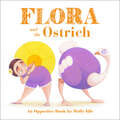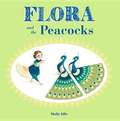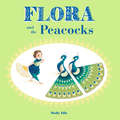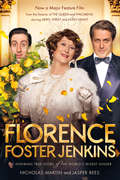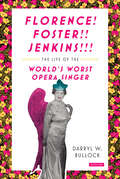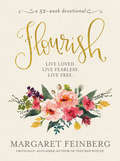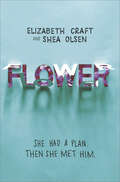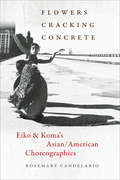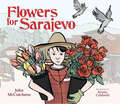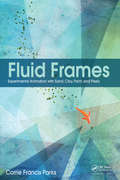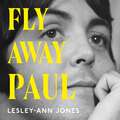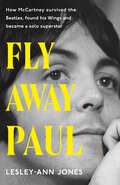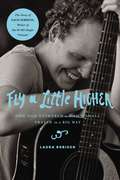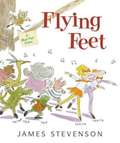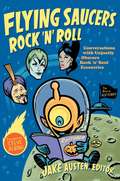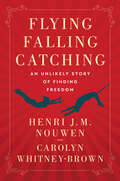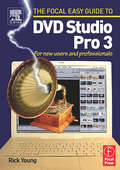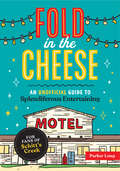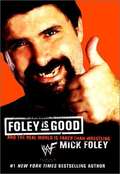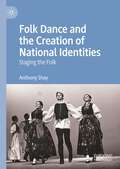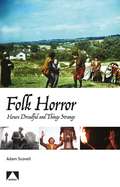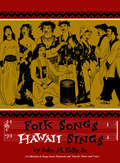- Table View
- List View
Flora and the Ostrich: An Opposites Book (Flora and Her Feathered Friends)
by Molly IdleInspired by Caldecott Honor book Flora and the Flamingo, this ebook is perfect for the very youngest Flora fans. When a new feathered friend seems so different from her, Flora discovers that opposites, in fact, attract! Featuring Molly Idle's graceful artwork, this adorable ebook of opposites will delight young children as they master new words and concepts. Plus, this is the fixed format version, which looks almost identical to the print edition.
Flora and the Ostrich: An Opposites Book (Flora and Her Feathered Friends)
by Molly IdleFrom a Caldecott Honor–winner—Learn about opposites and dance along as Flora attempts to befriend a shy ostrich. Inspired by Caldecott Honor book Flora and the Flamingo, this e-book is perfect for the very youngest Flora fans. When a new feathered friend seems so different from her, Flora discovers that opposites, in fact, attract! Featuring Molly Idle&’s graceful artwork, this adorable e-book of opposites will delight young children as they master new words and concepts. Plus, this is the fixed format version, which looks almost identical to the print edition. Praise for Flora and the Ostrich&“Children will be delighted. Opposites, friendship, and beautiful artwork all in one charmingly designed book.&” —Kirkus Reviews (starred review) &“In Ostrich, Flora befriends the long-necked bird. . . . Idle&’s characters, girl and birds alike, are wonderfully expressive, and the images have a timeless quality.&” —School Library Journal (starred review)</
Flora and the Peacocks
by Molly IdleThe darling, dancing Flora is back, and this time she's found two new friends: a pair of peacocks! But amidst the fanning feathers and mirrored movements, Flora realizes that the push and pull between three friends can be a delicate dance. Will this trio find a way to get back in step? In the third book featuring Flora and her feathered friends, Molly Idle's gorgeous art combines with clever flaps to reveal that no matter the challenges, true friends will always find a way to dance, leap, and soar--together.
Flora and the Peacocks
by Molly IdleThe darling, dancing Flora is back, and this time she's found two new friends: a pair of peacocks! But amidst the fanning feathers and mirrored movements, Flora realizes that the push and pull between three friends can be a delicate dance. Will this trio find a way to get back in step? In the third book featuring Flora and her feathered friends, Molly Idle's gorgeous art combines with clever flaps to reveal that no matter the challenges, true friends will always find a way to dance, leap, and soar—together.
Florence Foster Jenkins: The Inspiring True Story of the World's Worst Singer
by Jasper Rees Nicholas MartinFlorence Foster Jenkins was the most famous, though untalented, soprano in twentieth century America. Her extraordinary story is now a film directed by Stephen Frears starring Meryl Streep as the indomitable Florence Foster Jenkins and Hugh Grant as her husband/manager, St. Clair Bayfield. In this full-length biography tie-in to the film, Nicholas Martin, the scriptwriter, and Jasper Rees take a deeper look at her life and times. Born in Wilkes-Barre, Pennsylvania in 1868, Florence adored music, but her wealthy father refused to allow her to study in Europe. In 1909, she inherited a considerable sum of money when her father died. It was then that she began to take singing lessons, vowed to become a great soprano and met St Clair Bayfield. At seventy six, after a lifetime supporting classical music societies and giving self-financed recitals, she gave a solo concert at Carnegie Hall that drew Cole Porter, Gypsy Rose Lee and other luminaries to the sold-out hall. It was a night to remember. Florence felt she had triumphed, but the crowd roared with laughter. After a lifetime of singing to entertain others, she didn't know the one thing that everyone else did and that St. Clair Bayfield kept from her: she had a terrible voice and couldn't sing a note. Florence Foster Jenkins is the book everyone will be reading after Meryl Streep brings this unintentionally funny and ultimately heartbreaking American woman to life.
Florence Foster Jenkins: The Life of the World's Worst Opera Singer
by Darryl W. BullockFinally, a biography of Florence Foster Jenkins, considered the world's worst opera singer, soon to be portrayed by Meryl Streep in the forthcoming film. "Probably the most complete and absolute lack of talent ever publicly displayed." --Life Magazine Madame Jenkins couldn't carry a tune in a bucket: despite that, in 1944 at the age of 76, she played Carnegie Hall to a capacity audience and had celebrity fans by the score. Her infamous 1940s recordings are still highly-prized today. In his well-researched and thoroughly entertaining biography, Darryl W. Bullock tells of Florence Foster Jenkins meteoric rise to success and the man who stood beside her, through every sharp note. Florence was ridiculed for her poor control of timing, pitch, and tone, and terrible pronunciation of foreign lyrics, but the sheer entertainment value of her caterwauling packed out theatres around the United States, with the 'singer' firmly convinced of her own talent, partly thanks to the devoted attention for her husband and manager St Clair Bayfield. Her story is one of triumph in the face of adversity, courage, conviction and of the belief that with dedication and commitment a true artist can achieve anything.
Flourish: Live Free, Live Loved
by Margaret FeinbergWhat would a flourishing life look like for you? Take a moment to imagine. Instead of surviving your days, you savor each moment. Every hour you feel dazzlingly aware of God's love and presence. Join Margaret Feinberg for this 52-week devotional that's like reading a treasured letter from a longtime friend. Through her winsome stories and heart for Scripture's healing beauty, you'll discover deep encouragement on every page. Beautiful coloring pages beckon you to slow down and reflect on Scripture. Plant yourself in the depths of God's love.Grow in courage through persistent and consistent prayer.Blossom in freedom by facing the fears that hold you back. No matter what you've been through or what you're facing, God longs for you to thrive.A lush life awaits. Are you ready to flourish?
Flower
by Elizabeth Craft Shea OlsenThese are the things that I've always wanted: To get the top grades in my class. To make my grandmother proud. And most of all, proof that I could succeed where the rest of my family had not: a Stanford acceptance letter, early admission. My mother and my sister were obsessed with boys and love and sex. So obsessed that they lost sight of their futures, of what they wanted. And in the end, they lost everything. I'll never let a boy distract me. I promised myself that. But that was before Tate. Before the biggest pop star on the planet took an interest in me. Before private planes and secret dates and lyrics meant for me alone. There's so much I don't know. Like why he left music. Where he goes when we're not together. What dark past he's hiding. But when we kiss, the future feels far away. And now...I'm not sure what I want.
Flowers Cracking Concrete: Eiko & Koma’s Asian/American Choreographies
by Rosemary CandelarioFlowers Cracking Concrete is the first in-depth study of the forty-year career of Eiko & Koma--two artists from Japan who have lived and worked in New York City since the mid-1970s, establishing themselves as innovative and influential modern and postmodern dancers. They continue to choreograph, perform, and give workshops across the United States and around the world. Rosemary Candelario argues that what is remarkable about Eiko & Koma's dances is not what they signify but rather what they do in the world. Each chapter of the book is a close reading of a specific dance that reveals a choreographic theme or concern. Drawing on interviews, live performance, videos, and reviews, Candelario demonstrates how ideas have kinesthetically and choreographically cycled through Eiko & Koma's body of work, creating dances deeply engaged with the wider world through an active process of mourning, transforming, and connecting.
Flowers for Sarajevo
by John McCutcheonYoung Drasko is happy working with his father in the Sarajevo market. Then war encroaches. Drasko must run the family flower stand alone.One morning, the bakery is bombed and twenty-two people are killed. The next day, a cellist walks to the bombsite and plays the most heartbreaking music Drasko can imagine. The cellist returns for twenty-two days, one day for each victim of the bombing. Inspired by the musician's response, Drasko finds a way to help make Sarajevo beautiful again.Inspired by real events of the Bosnian War, award-winning songwriter and storyteller John McCutcheon tells the uplifting story of the power of beauty in the face of violence and suffering. The story comes to life with the included CD in which cellist Vedran Smailović accompanies McCutcheon and performs the melody that he played in 1992 to honor those who died in the Sarajevo mortar blast.
Fluid Frames: Experimental Animation with Sand, Clay, Paint, and Pixels
by Corrie Francis ParksOnce the realm of a few stalwart artists, animating with sand, clay, and wet paint is now accessible for all filmmakers with an experimental frame of mind. Created directly under the camera with frame-by-frame stopmotion, this "fluid frame animation" provides a completely unique visual world for animators. While pioneering animators such as Caroline Leaf, Alexander Petrov, and Ishu Patel paved the way, the availability of frame capture programs, compositing software and digital workflow is opening up new avenues of exploration for artists of all experience levels. This book will walk you through setting up your studio, choosing and working with your materials, and combining the physical under-the-camera production with digital compositing and effects to enhance your animation.· Firsthand advice from experimental animation veterans and rising stars in the field· Covers the digital aspects of experimental animation, including the latest techniques in After Effects CC· Tutorials and source files for under-the-camera approaches and After Effects enhancements on the book’s companion website In addition to the practical advice, you’ll find historical and contemporary examples of successful films, step-by-step tutorials for working under the camera and working with the footage digitally, and interviews and tips from artists who are currently pushing the boundaries in these experimental mediums. Stacked with information and images from over 30 artists, this book is an indispensable resource for both the student and professional wishing to get their hands dirty in an increasingly digital world.
Fluid Screens, Expanded Cinema
by Janine Marchessault Susan LordAs a medium, film is constantly evolving both in form and in content. Fluid Screens, Expanded Cinema considers the shift from traditional cinema to new frontiers of interactive, performative, and networked media.Using the theories of Marshall McLuhan and Gilles Deleuze as a starting point, renowned scholars from the fields of film theory, communication studies, cultural studies, and new media theory explore the ways in which digital technology is transforming contemporary visual culture. The essays consider a series of questions: What constitutes the "new" in new media? How are digital aesthetics different from film aesthetics? What new forms of spectatorship and storytelling, political community, and commodity production are being enabled through the digital media?Using Gene Youngblood's 1970 book Expanded Cinema as an anchor for the volume, Fluid Screens, Expanded Cinema understands the digital not simply as a technological form, but also as an experience of space and time that is tied to capitalism. This important collection is unique in framing a range of social justice issues with aesthetic theories of new digital screen culture that will appeal to scholars and multimedia artists prepared to break new ground.
Fly Away Paul: The extraordinary story of how Paul McCartney survived the Beatles and found his Wings
by Lesley-Ann JonesThe first definitive account of Paul McCartney's time in Wings, to be published on the 50th anniversary of the bestselling album Band on the RunNo comprehensive biography of the time Paul McCartney spent with Wings has ever been published. A period often dismissed as McCartney's 'missing' years, in fact the band lasted for a decade: two years longer than the Beatles, and wielded such impact and influence that they at one point achieved the status as the biggest live band in the world. Band on the Run sold over 6 million copies worldwide and became EMI's biggest selling album of the 1970s in the UK.Music biographer Lesley-Ann Jones has met McCartney many times and knew his late wife Linda. Here she shows how crucial Linda was to the evolution of Wings - at great cost to herself given the ridicule she was to encounter. But Linda saw that McCartney needed the band in the wake of the break up of the Beatles.Drawing on extensive interviews and her trademark meticulous research, the author shows how this period in Paul McCartney's career was to become crucial not only to his development as an artist, but to his very survival.(P)2023 Hodder & Stoughton Limited
Fly Away Paul: The extraordinary story of how Paul McCartney survived the Beatles and found his Wings
by Lesley-Ann JonesPre-order the remarkable account of Paul McCartney's time in Wings and ascent into solo stardom, by renowned music biographer Lesley-Ann JonesNo comprehensive biography of the time Paul McCartney spent with Wings has ever been published, until now.A period often dismissed as McCartney's 'missing' years, in fact the band lasted for a decade: two years longer than the Beatles, and wielded such impact and influence that they at one point achieved the status as the biggest live band in the world. Band on the Run sold over 6 million copies worldwide and became EMI's biggest selling album of the 1970s in the UK. Music biographer Lesley-Ann Jones has met McCartney many times and knew his late wife Linda. Here she shows how crucial Linda was to the evolution of Wings - at great cost to herself given the ridicule she was to encounter. But Linda saw that McCartney needed the band in the wake of the break up of the Beatles. Drawing on extensive interviews and her trademark meticulous research, the author shows how this period in Paul McCartney's career was to become crucial not only to his development as an artist, but to his very survival.
Fly a Little Higher: How God Answered One Mom's Small Prayer in a Big Way
by Laura SobiechLaura Sobiech tells the amazing story of how God used her son's battle with cancer to touch the lives of millions. "Okay, Lord, you can have him. But if he must die, I want it to be for something big. I want someone's life to be changed forever. " This is what Laura Sobeich prayed when she found out her seventeen-year-old son had only one year to live. With this desperate prayer, she released her son to God's will. At that point, Zach Sobiech was just another teenager battling cancer. When his mother told him to think about writing good-bye letters to family and friends, he decided instead to write songs. One of them, "Clouds," captured hearts and changed not one life but millions, making him an international sensation. He produced a full-length EP, written and performed by Zach and his lifelong friend, Sammy, including a personal goodbye song to each other. The day of Zach's funeral, "Clouds" was the #1 downloaded song on iTunes, and the EP rose to #2. The music video now has more than 7 million views on YouTube, and the documentary Soul Pancake released on Zach's eighteenth birthday has more than 9 million views. But Zach's story is not just about music. It's a testament to what can happen when you live as if each day might be your last. It's a story about the human spirit. It's about how God used a dying boy from a small town in Minnesota to touch the hearts of millions-including top executives in the music industry, major music artists, news anchors, talk show hosts, actors, priests and pastors, and school children across the globe. Zach once said, "I want to be known as the kid who went down fighting, and didn't really lose. " Fly a Little Higher is about how God used Zach to do something big.
Flying Feet: A Mud Flat Story
by James StevensonWhat's that noise? Is it a bunch of giant woodpeckers? No, it's the amazing tap-dance team of Tonya and Ted, who've come to Mud Flat to produce a big dance extravaganza. And now that they've soft-shoed their way into town, all the residents are eager to fork over plenty for tap-dance lessons. How else will they become stars?
Flying Funny: My Life without a Net
by Dudley RiggsDudley Riggs didn&’t have to run away from home to join the circus. Home was the circus. Son of the acclaimed aerial flyers Riggs and Riggs, he made his circus debut as a polar prince parading in a wagon pulled by a polar bear. At the age of five, he graduated to a risqué vaudeville act during the circus off- season; at eight, he outgrew his cutes (and his child stardom) and joined his high-flying parents on the trapeze. Eventually he had to learn to &“fly funny&” because he grew too tall to fly straight. In one way or another, Riggs has been flying ever since.The rest, as they say, is history. And what a story it is. In Flying Funny, Riggs shares many highs and lows while describing circus life and the evolution of America&’s popular entertainment during the twentieth century. From his early life in circus and vaudeville to his creation of the Brave New Workshop, we see how his show business experience and instincts helped him create in Minneapolis what became the &“next wave&” in American entertainment—improvisation. As a young man, Riggs lost everything in a tornado, got an education on the fly, and sailed with the All American circus to post–war Japan. On a slow boat home and restless about his future, he developed the idea of Word Jazz—creating a script on stage as it is being performed—and shortly after he opened the Instant Theater in New York. Later, he moved to Minneapolis where he founded the Brave New Workshop, launching the careers of comic greats such as Penn and Teller, The Flying Karamazov Brothers, Louie Anderson, Peter Tolan, Pat Proft, Nancy Steen, Liz Winstead, Al Franken and many others. Today, the Brave New Workshop thrives as the longest running improvisational theater in America. From flying funny on the trapeze to theater without a net, Dudley Riggs&’s story is filled with hearty laughs and eyebrow-raising insights. With a wry sense of humor and infectious warmth, he shares the exhilaration of flying whether through the air or on the stage.
Flying Saucers Rock 'n' Roll: Conversations with Unjustly Obscure Rock 'n' Soul Eccentrics
by Jake AustenFor nearly twenty years, the much-beloved music magazine Roctober has featured work by some of the best underground cartoonists, exhaustive examinations of made-up genres such as "robot rock," and an ongoing exploration of everything Sammy Davis Jr. ever sang, said, or did. But the heart of the magazine has always been the lengthy conversations with overlooked or forgotten artists. Flying Saucers Rock 'n' Roll gathers the most compelling of these interviews. Eccentric, important artists--including the rockabilly icon Billy Lee Riley, the jazz musician and activist Oscar Brown Jr. , the "Outlaw Country" singer David Allan Coe, and the pioneer rock 'n' roll group the Treniers--give the most in-depth interviews of their lengthy careers. Obscure musicians, such as the Armenian-language novelty artist Guy Chookoorian and the frustrated interstellar glam act Zolar X, reveal fascinating lives lived at rock's margins. Roctober's legendarily dedicated writers convey telling anecdotes in the fervent, captivating prose that has long been appreciated by music enthusiasts. Along with the entertaining interviews, Flying Saucers Rock 'n' Roll features more than sixty images from the pages of Roctober and ten illustrations created for the book by the underground rock 'n' roll artist King Merinuk. Contributors Steve Albini Ben Austen Jake Austen John Battles Bosco Ken Burke Mike Maltese King Merinuk Ken Mottet Jonathan Poletti James Porter "Colonel" Dan Sorenson Jacqueline Stewart
Flying, Falling, Catching: An Unlikely Story of Finding Freedom
by Henri J. Nouwen Carolyn Whitney-BrownHenri Nouwen’s never-before-published story of his surprising friendship with a traveling trapeze troupe.During the last five years of his life, best-selling spiritual author Henri J. M. Nouwen became close to The Flying Rodleighs, a trapeze troupe in a traveling circus. Like Nouwen’s own life, a trapeze act is full of artistry, exhilarating successes, crushing failures and continual forgiveness. He wrote about his experience in a genre new to him: creative non-fiction. In Flying, Falling, Catching, Nouwen's colleague and friend Carolyn Whitney-Brown presents his unpublished trapeze writings framed by the true story of his rescue through a hotel window by paramedics during his first heart attack. Readers will meet Nouwen as a spiritual risk taker who was transformed through his engagement with these trapeze artists, as well as his participation in the Civil Rights movement, his life in community with people with intellectual disabilities, his personal growth through friendships during the 1990s AIDS pandemic, and other unexpected encounters.What will we do with our lives, and with whom will we do it? In this story of flying and catching, Nouwen invites us all to let go and fly, even when we are afraid of falling.
Focal Easy Guide to DVD Studio Pro 3: For new users and professionals
by Rick YoungThis highly illustrated, full color book tells you all you need to know to get up and running quickly using DVD Studio Pro to achieve professional results. All the essential areas are covered: preparing your assets, the DVD SP interface, setting up your DVD, adding tracks, building menus, adding markers, building slideshows, making subtitles and multiplexing. An invaluable first read for users of all levels who want to author DVDs professionally!
Fold in the Cheese: An Unofficial Guide to Splendiferous Entertaining for Fans of Schitt's Creek
by Parker LongWhether they&’re throwing ostentatious soirées or Valium-fueled tantrums, entertaining a crowd (and sometimes just Stevie) is what the Roses do best! Let their sagacious advice and biting wit wash over you with Fold In The Cheese: An Unofficial Guide to Splendiferous Entertaining for Fans of Schitt's Creek. Recipes like &“Cardamom Rose Cocktail&”, &“Johnny&’s Hundred-Dollar Sliders&”, and &“Chocolate Ganache Torte&” will titillate taste buds while tips on how to put on a proper game night, host a holiday party, and even organize your own movie premiere will help to create a most consummate atmosphere for hosting. This illustrious tome gives you everything you need to create an event that&’s sure to be . . . memorable.
Foley is Good
by Mick FoleyAutobiography of the wrestling champion, bestselling author, and father of 3.
Folk Dance and the Creation of National Identities: Staging the Folk
by Anthony ShayThis book is about the folk: the folk in folk dance, the folk in folklore, the folk in folk wisdom. When we see folk dance on the stage or in a tourist setting, which is the way in which many of us experience folk dance, the question arises are these the “real folk” performing their authentic dances? Or are they urban, well trained, carefully-rehearsed professional dancers who make their livelihood as representatives of a specific nation-state acting as the folk? Or something in between? This study delves more deeply into the folk, their origins, their identities in order to know the source of inspiration for ethno identity dances - dances prepared for the stage and the ballroom and for public performances from ballet, state folk dance ensembles and their amateur emulators, immigrant folk dance group performances, and tourist presentations. These dances, unlike modern dance, ballet, or most vernacular dances, always have strong ethnic references. It will also look at a gallery of choreographers and artistic directors across a wide spectrum of dance genres.
Folk Horror: Hours Dreadful and Things Strange (Auteur Ser.)
by Adam ScovellInterest in the ancient, the occult, and the "wyrd" is on the rise. The furrows of Robin Hardy (The Wicker Man), Piers Haggard (Blood on Satan's Claw), and Michael Reeves (Witchfinder General) have arisen again, most notably in the films of Ben Wheatley (Kill List), as has the Spirit of Dark of Lonely Water, Juganets, cursed Saxon crowns, spaceships hidden under ancient barrows, owls and flowers, time-warping stone circles, wicker men, the goat of Mendes, and malicious stone tapes.Folk Horror: Hours Dreadful And Things Strange charts the summoning of these esoteric arts within the latter half of the twentieth century and beyond, using theories of psychogeography, hauntology, and topography to delve into the genre's output in film, television, and multimedia as its "sacred demon of ungovernableness" rises yet again in the twenty-first century.
Folk Songs Hawaii Sings
by John M. KellyFolk Songs Hawaii Sings is a sparkling compilation of melodies from the islands of Polynesia together with a variety of folk songs that countless Oriental people have brought with them to their new home in the Hawaiian Islands. In one sense it is a musical picture of the renowned harmonious blend of people who reside in Hawaii today; in another, it is a colorful record of ties with the Eastern world and ancestral heritage in line with the same American tradition that saw songs of the soil and the sea brought to the United States from Europe in an earlier age.All the songs and more, whether from Hawaii or Samoa, China or Japan, the Philippines, Okinawa, or Mongolia, are melodic bearers of traditions and aspirations, or vehicles of simple pleasures that form the background of the people who today share the hospitable sun of the Hawaiian Islands with their Caucasian neighbors. These melodies and rhythms have found their way into the many festivals and musical presentations that are so much a way of life in the welcome addition to the American Union.
